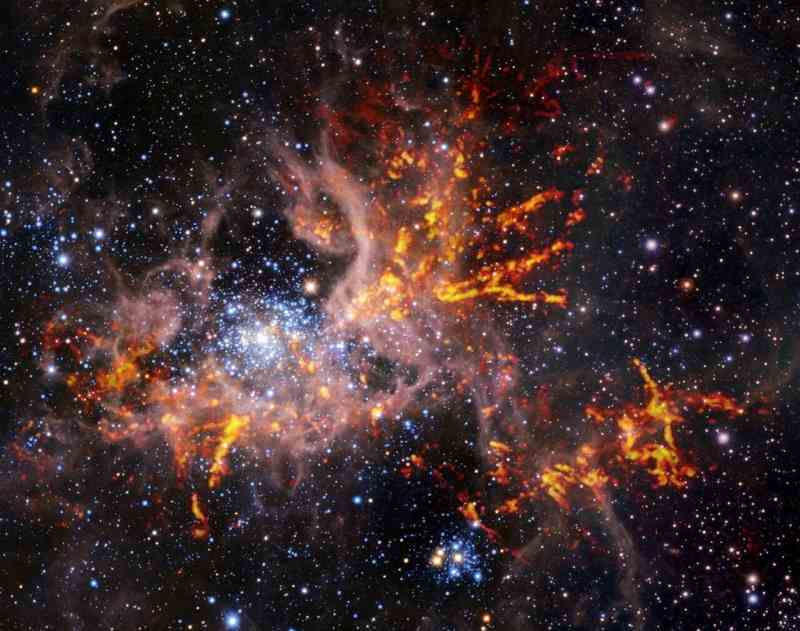
A composite image shows the star-forming region called 30 Doradus, also known as the Tarantula Nebula. The background image, taken in infrared, was captured by the HAWK-I instrument on ESO’s Very Large Telescope (VLT) and the Visible and Infrared Survey Telescope for Astronomy (VISTA) and shows bright stars and light, pinkish clouds of hot gas. The bright red-yellow streaks superimposed on the image come from radio observations taken by the Atacama Large Millimeter / submillimeter Array (ALMA), revealing regions of cold, dense gas that have the potential to collapse and form stars.
18:23 JST, July 13, 2022
WASHINGTON (Reuters) — Astronomers have peered into a teeming stellar nursery in the Tarantula Nebula — a colossal cloud of gas and dust next door to our galaxy — gaining new understanding of the dynamics of star formation while obtaining a dazzling image of the cosmos.
Researchers on June 15 said their observations offered insight into the interplay between the irresistible force of gravity that drives star formation and the huge amounts of energy that massive young stars inject into their nearby environments that could inhibit stellar birth.
The Tarantula Nebula, residing in a satellite galaxy of the Milky Way called the Large Magellanic Cloud, is a web of stars, gas and dust with a diameter around 600 light-years. A light year is the distance light travels in a year — 9.5 trillion kilometers.
Located about 170,000 light years from Earth, the Tarantula Nebula is formally named 30 Doradus, referring to a catalog number for objects in the direction of the constellation Dorado.
It is called the Tarantula Nebula because some of its architecture appears as glowing filaments of gas, dust and stars reminiscent of spider legs. The nebula’s gas composition is similar to the universe’s earlier in its history, mostly just hydrogen and helium.
The European Southern Observatory released a Tarantula Nebula image showing wispy gas clouds that may be remnants of larger ones ripped apart by energy unleashed by massive young stars.
“We see stars forming where there is a lot of gas and dust available, and there is definitely a lot of it in the Tarantula Nebula,” said astrophysicist Guido De Marchi of the European Space Agency’s European Space Research and Technology Centre in the Netherlands, coauthor of the research published in the Astrophysical Journal and presented at an American Astronomical Society meeting.
The findings were aided by observations using the Chile-based ALMA telescope.
“Stars form when gas clouds collapse under their own gravity and the gas gets denser and denser. These clouds contract and warm up until the core is hot enough to start the stellar engine, an immense nuclear reactor,” De Marchi said.
“But we always thought that when massive stars — over 100 times more massive than the sun — begin to form they release so much energy that it prevents the infall of more gas, shutting off the fuel for more stars to form. The beautiful observations of the Tarantula Nebula obtained with ALMA now show that where the gas is dense enough it continues to fall unabated and new stars can keep forming. This is interesting and new,” he said.
De Marchi was referring to a phenomenon called feedback, with massive young stars emitting large amounts of energy into their local environments in the form of photons and high-speed particles. The nebula’s primordial composition has fostered the formation of particularly large stars, some 200 times as massive as our sun.
“The Tarantula Nebula is the most extreme feedback environment that we can observe in detail because it hosts the nearest example of a massive young star cluster,” University of Illinois astrophysicist and study lead author Tony Wong said.
“One of the big mysteries in astronomy is why we are still able to witness stars forming today. Why didn’t all of the available gas collapse in a huge burst of star formation that came and went long ago? Observations with ALMA can shine a light on what is happening deep within clouds and help us understand how gravity and feedback compete for influence to keep the rate of star formation under control,” Wong added.
The nebula’s sheer beauty was not lost on the researchers.
“I personally love the Tarantula Nebula, both scientifically and aesthetically,” De Marchi said. “It is just an iconic scene in the sky. I have often wondered what the night would look like if we were on a planet around one of its stars, with colorful bright clouds and strings of gas crisscrossing the sky.”
"Science & Nature" POPULAR ARTICLE
-

Mass Oyster Die-Offs Confirmed in Japan’s Seto Inland Sea; High Water Temperature Cited as Primary Cause
-

Genome Study Reveals Milestone in History of Cat Domestication
-

Big Leap in Quest to Get to Bottom of Climate Ice Mystery
-

Security Camera Footage Vulnerable to Outside Access; Investigation Finds 3,000 Pieces Exposed Online
-

Paws on Parade: Nairobi’s Dogs Dazzle at ‘Pawchella’
JN ACCESS RANKING
-

Keidanren Chairman Yoshinobu Tsutsui Visits Kashiwazaki-Kariwa Nuclear Power Plant; Inspects New Emergency Safety System
-

Imports of Rare Earths from China Facing Delays, May Be Caused by Deterioration of Japan-China Relations
-

University of Tokyo Professor Discusses Japanese Economic Security in Interview Ahead of Forum
-

Japan Pulls out of Vietnam Nuclear Project, Complicating Hanoi’s Power Plans
-

Govt Aims to Expand NISA Program Lineup, Abolish Age Restriction























